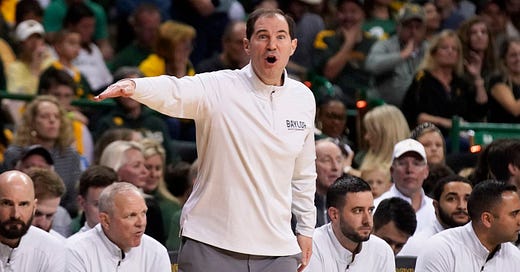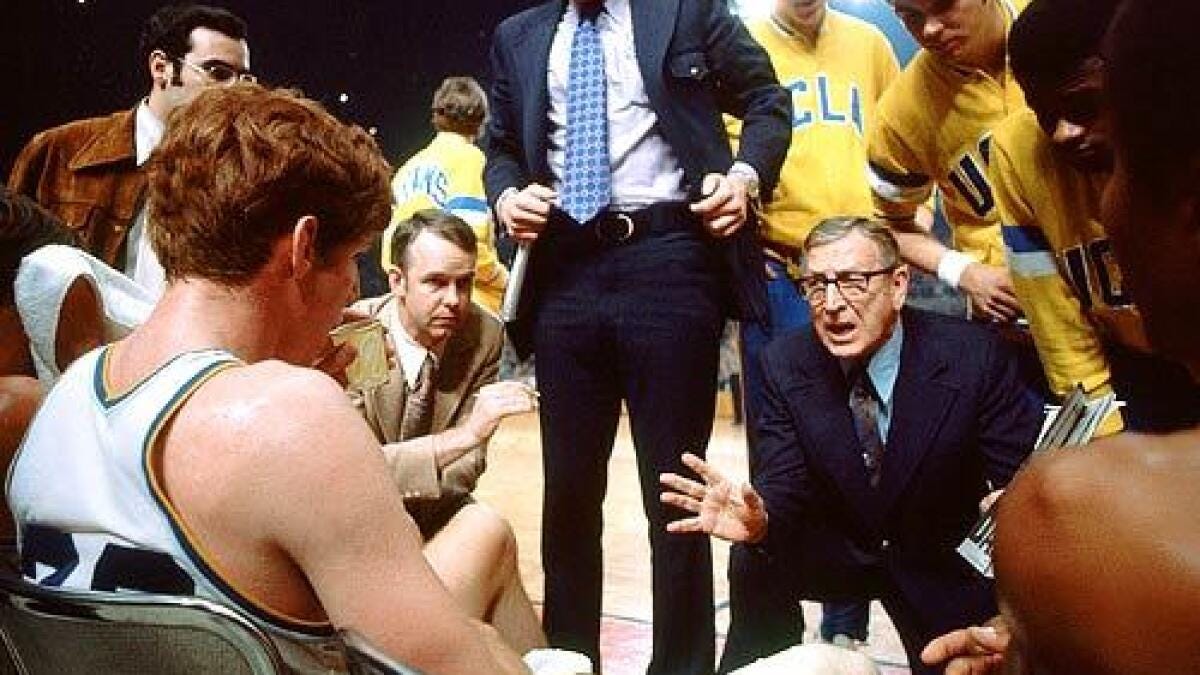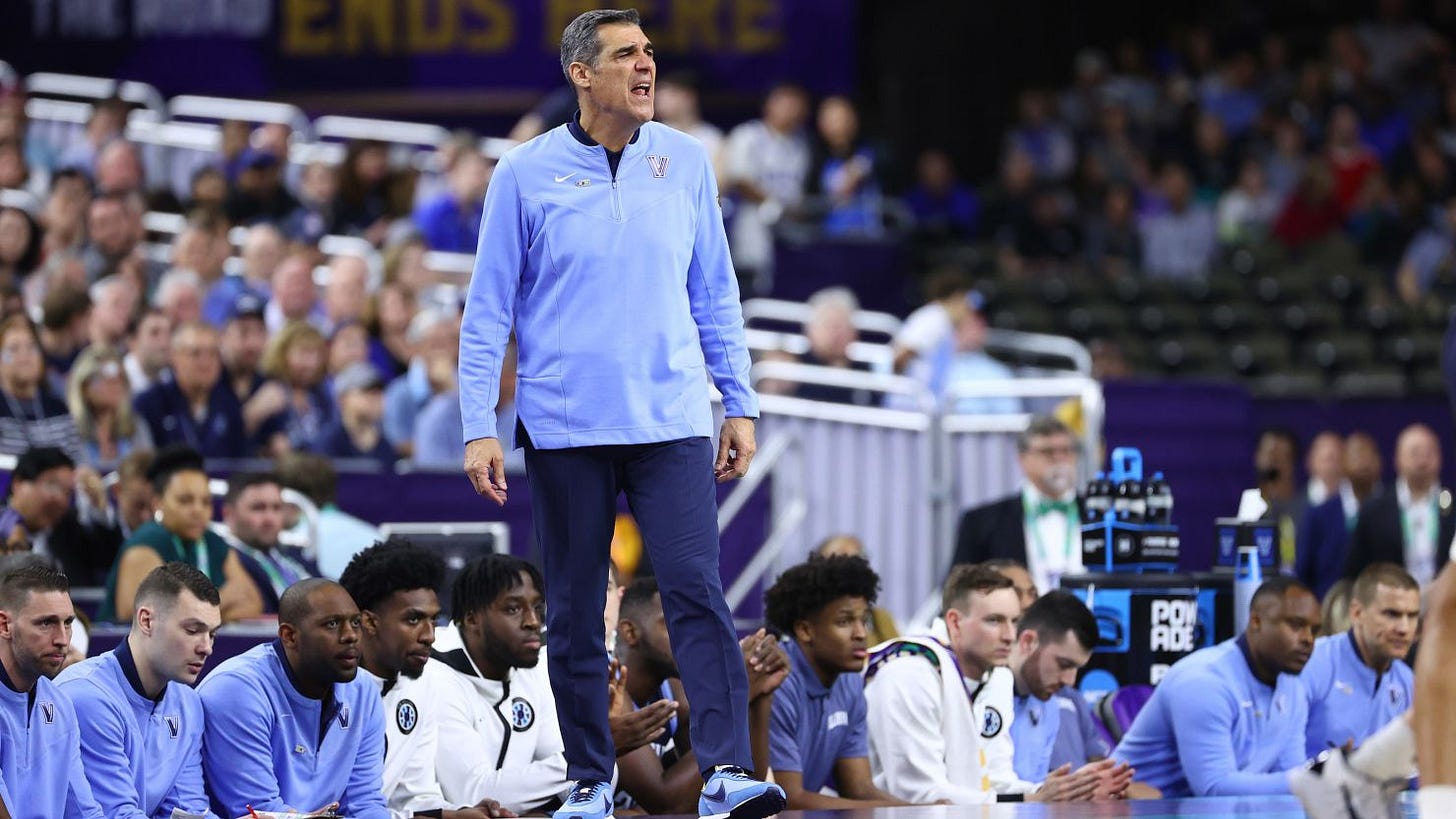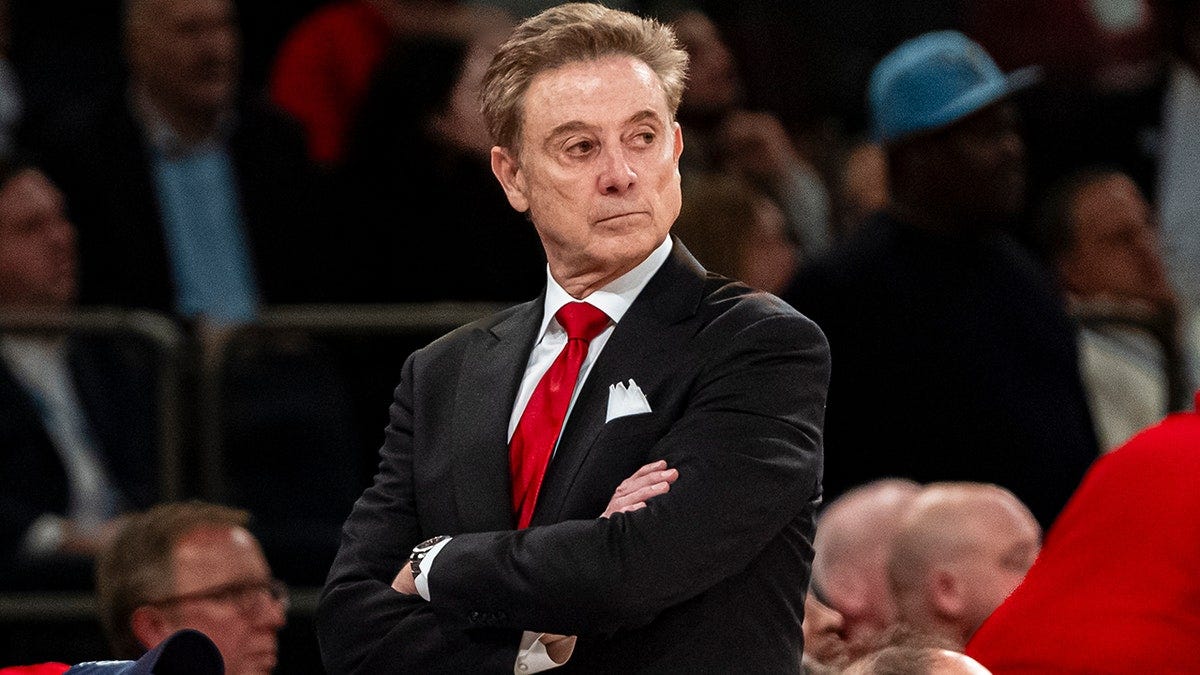Why I miss college basketball coaches in suits
I used to think it was absurd that people wore suits while coaching a game. Our current quarter-zip-and-khaki hell has me thinking otherwise
On Feb. 4, St. John’s knocked off No. 11 Marquette 70-64 in one of the most anticipated men’s college basketball games of the week.
It was a validating moment for the Red Storm, who have spent the vast majority of this century in college basketball’s wilderness. The win was the first against a ranked opponent during the 2024-25 season for Rick Pitino’s team, proving there was more to its 19-3 start than beating up on a less-than-daunting schedule. The victory came in front of nearly 17,000 fans crammed inside Madison Square Garden, with the hallowed venue buzzing in a way it seldom has for the Johnnies over the past three decades. It even prompted at least one column from a major media outlet openly wondering if Pitino is the greatest coach of all-time.
As much as I enjoyed the spectacle unfolding on my television nearly 2,000 miles away from midtown Manhattan, there was something else that caught my eye.
Shortly after the final horn blared and an already jubilant crowd let out a final round of cheers, Pitino and Marquette’s Shaka Smart met at midcourt and shook hands. It’s something college coaches do after most every game, but what was most striking to me was the contrast between the two men, not because one was overjoyed about his team winning and the other dejected about his squad losing, but because of what they were wearing – Pitino in one of his impeccably tailored, lord-knows-how-expensive suits and Smart in a Marquette-branded navy blue polo with a tight-fitting, long-sleeved undershirt that looks like something a quarterback wears during a frigid NFL playoff game.
If it was put into the context of a battle, it was the triumph of formal attire over casual wear, but more than that, it was more reflective of where college basketball finds itself from a sartorial standpoint in 2025. A sport in which every coach used to dress like Pitino – well, not exactly like Pitino – has seen more laid-back attire like Smart’s become the norm.
I’ve gotta say – I’ve got some mixed feelings about it.
The history of suits and college basketball
As long as there has been college basketball, there have been coaches roaming the sidelines wearing suits.
What’s Dr. James Naismith wearing in the iconic photo of him holding a peach basket and a ball? A three-piece wool suit. When Oregon hoisted the first NCAA championship in 1939, there was coach Howard Hobson with a pinstriped suit jacket, pants and a tie. John Wooden wore a similar ensemble while piloting the UCLA dynasty of the 1960s and 1970s.
By the 1980s, Pat Riley was donning Armani suits in the NBA, looking fittingly dapper while pulling the strings for the Showtime Lakers. Riley became a template for many others, from Pitino to Jay Wright, who rocked tailored suits that cost roughly a year of college tuition (at least at that time).
While wearing a suit became a custom for coaches, it never really made sense.
As ridiculous as it is seeing pot-bellied, middle-aged men wearing the same things as their much younger players, baseball managers wear full uniforms because they step on the field of play during the course of a game and have to adhere to the attire of those who step between the foul lines. Football coaches wear an assortment of polos and hoodies (sleeves sometimes optional). Hockey coaches, too, wear suits, but if nothing else, it’s a way to stay warm while standing next to a giant sheet of ice.
Basketball coaches, though, are quite active on the sideline – crouching, pacing furiously, occasionally sprinting in the direction of a referee who makes a questionable call. Suits and similar formal wear serve a function, but none of those things fall under the umbrella of those workplace requirements. It led to some funny visuals over the years, from Sean Miller sweating through his white dress shirt to Ed Cooley ripping his pants and covering it up with a sweat towel.
But for whatever self-satisfaction and ego inflation coaches get from looking debonair in front of thousands of people (and millions more on TV), it’s an undeniably uncomfortable experience.
“It’s completely bizarre,” Deirdre Clemente, a fashion and culture historian and a professor at UNLV, told me five years ago. “Not only is it counterintuitive to the nature of what they’re doing, but it’s also counterintuitive to the very nature of sports. Sportswear is the basis of the casual wardrobe.”
Even as suits dominated the sport, there were exceptions. Bob Knight wore red sweaters and pullovers during his reign at Indiana, often with a white dress shirt underneath. Lou Carnesecca famously had his collection of sweaters. Though he’d occasionally suit up, Bob Huggins wore various track suits and pullovers, becoming the face of casual wear in modern college basketball.
Even before 2020, some started to follow suit (no pun intended), with coaches like Duquesne’s Keith Dambrot wearing quarter-zips and khakis.
“I just don’t see the point of it,” Dambrot said of suits to me five years ago. “We’re basketball coaches. We’re not bankers.”
Then, as it did for the entire world, the COVID-19 pandemic changed everything.
While playing through a global pandemic and in largely empty arenas, coaches understandably began to care far less about how they looked. They were no longer performers on a stage, but men coaching a bunch of 18-to-22 year olds who simply wanted to be comfortable while working through unprecedented circumstances. Even suit stalwarts like Pitino and Mick Cronin acknowledged it would be more than a little weird to wear their usual gameday attire in front of a bunch of empty seats.
The ACC and Big Ten adopted measures that had coaches in less formal attire, with virtually everyone reverting to quarter-zips and khakis. Other leagues followed with similar initiatives or, at the very least, their coaches came upon the new look organically.
When Wright, a man who literally appeared in a spread in the pages of GQ, abandoned suits, it was clear that this aesthetic movement had some legs (though in Wright’s case, that was partially due to his longtime tailor, Gabriele “Gabe” D’Annunzio, dying of COVID in Jan. 2021).
Once vaccines were widely available and arenas filled up again, the look largely stayed. There are some notable exceptions who returned to the old ways, but for the most part, sidelines looked the way they would at a high-school game or AAU event.
Why that’s the case isn’t especially hard to understand.
Once coaches got to experience what they had been missing for so many years, they didn’t have any desire to go back, particularly since there wasn’t any real social or administrative pressure to do so. In theory, it’s not all that different than all of those newspapers that put their content previously reserved for subscribers online for free and expected those consumers to one day be willing to pay again for news.
“Coaches want to present themselves in a certain way,” Pitt’s Jeff Capel once told me. “As I’ve gotten older — not older in the profession, just older — I’ve become more comfortable with who I am and what I believe in. I understand that more so now than I did years ago that not everyone is not going to believe in me and everyone’s not going to agree with the stuff that I do. That’s fine. You can’t please everyone. But when it comes to certain things like this, I’m just trying to be comfortable.”
There was no longer the hassle of ties, which could constrict a coach’s neck and make screaming across the court to their players an act of misery without at least unbuttoning the top button of a dress shirt. Even coaches who didn’t mind wearing suits hated dress shoes and let out an audible sigh whenever it came time for Coaches vs. Cancer games in which they could wear a pair of Jordans instead. If you want those cozier shoes, and unless you want to look like a goof during an event that’s not raising awareness for cancer research, it can’t regularly come with a suit.
Perhaps the biggest thing is that coaches are, by their nature, sticklers for uniformity. While everyone wearing a suit offered that to an extent, wearing the same university-issued apparel makes the concept of a team that much easier to sell and embrace, even if just visually. The schools like it, too, with coaches on national TV wearing their logos rather than some hard-to-pronounce designer.
Justifiable as all of this is, it doesn’t mean it’s good for the sport.
Where things stand in college basketball coaching fashion and what needs to change
To be clear, Pitino isn’t out there alone trying to stoke the dying embers of a lost cause every time he laces up a pair of dress shoes.
Cronin continues to wear suits and, true to his nature, hasn’t been shy about sharing why.
“I just don’t want to look like I’m coaching a summer game,” he said to the Los Angeles Times in Feb. 2022. “I just think it’s the professional thing to do, and I get what other guys are doing [but] I look at it differently; I will never dress casual. Here I am getting to coach at UCLA, literally blocks from Hollywood and miles from where Pat Riley walked the Forum sidelines in Armani suits, obviously Coach Wooden, the most professional coach and teacher ever, but I don’t do it just because I sit in coach Wooden’s seat.”
Maryland’s Kevin Willard does the same, though it’s perhaps not a coincidence that he and Cronin are both Pitino proteges. Texas A&M’s Buzz Williams still wears suits, as does Colorado’s Tad Boyle, among others.
“If a game for a college basketball coach is not significant enough to wear a coat and tie, what is? Going to a funeral? Going to a wedding?” Boyle told me two years ago. “I guess it’s a bigger question of what’s worth getting dressed up for and what’s not. I’m not one to judge. But I am one to say that it’s one out of 31 days a year I’m guaranteed to coach a basketball team. It’s worthy of a coat and tie.”
To some of you reading this, these sentiments can reek of ego, self-importance or a misplaced commitment to a nonsensical tradition. There’s a time when I would have likely thought the same, though as someone who subscribes to what Boyle described – I’m only wearing a suit if someone’s getting married or just died – I’m probably not the most impartial voice on the matter.
Increasingly, though, I’m coming to their side.
College basketball fashion has gotten boring. In the not-so-distant past, everyone wore suits, but there wasn’t anything uniform about it. Each coach’s suit said something about them. Pitino was the quintessential mafia don. Mike Brey, with his mock turtlenecks under his suits, could have passed for a Bond villain if he weren’t so damn likable. Kevin Stallings, at least when I covered him during his ill-fated tenure at Pitt, wore frumpy suits that looked like they came off a department store rack.
With quarter-zips, khakis and polos, none of those shreds of personality that once existed are detectable anymore. Everyone literally looks the same. Part of Huggins’ charm was that he was one of the only people who dressed the way he did. Were he still coaching, he’d be largely indistinguishable from three-quarters of the sport from the neck down.
It’s to the point now where it’s the Pitinos and Cronins of the world who are the rebels bucking up against the college basketball fashion establishment despite very literally being the suits that so many renegades over the course of modern American history railed against. At the very least, they offer us some much-needed variety in what has become a homogenized profession.
Should we return to the suit-dominated, pre-COVID world, when ditching ties was seen as a notable act of courage? No. But there’s a lot of room between what a coach would wear to a board room and what they put on to go to Target on a Tuesday morning that should be explored, but so often hasn’t.
For years, I wondered why more coaches didn’t follow the example of Louisville women’s basketball coach Jeff Walz’s business casual look, with a button-up shirt (and no tie) tucked into a pair of khakis. Maybe someone could do a slight tweak on that look and wear a pair of jeans.
You get a better sense of what the future of college basketball coaching fashion could be watching European soccer. While many, especially in the English Premier League, bundle up under puffy jackets in the winter, look at what accomplished coaches like Pep Guardiola, Mikel Arteta and newly hired U.S. Men’s National Team manager Mauricio Pochettino wear when it’s not freezing outside – snazzy-but-understated long-sleeved shirts and a nice pair of pants, perhaps maybe with a less formal sport coat. What’s stopping someone from mirroring Dawn Staley and rocking a Gucci hoodie? Even if those designer, high-priced items don’t align with your personality or budget, find something that differentiates you a bit. Hell, be a slob who wears joggers and a Costco-brand hoodie. At least you’ll stand out from a crowd of people who look more like boosters sitting courtside than a coach.
There are, of course, far bigger issues facing college basketball. Chatter has intensified that the NCAA Tournament is going to expand. Schools are preparing for how they’re going to pay their athletes once the dust fully settles from the House settlement. And, lest we forget, how many damn video reviews there have been, often pushing games well past their customary two hours.
But, in the middle of all of that, is it too much to ask coaches to be a little more imaginative with how they present themselves to the world?
(Photos: Associated Press, Los Angeles Times, Getty Images)








